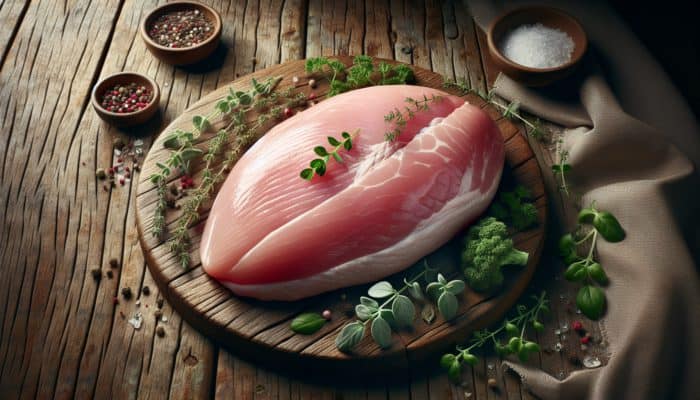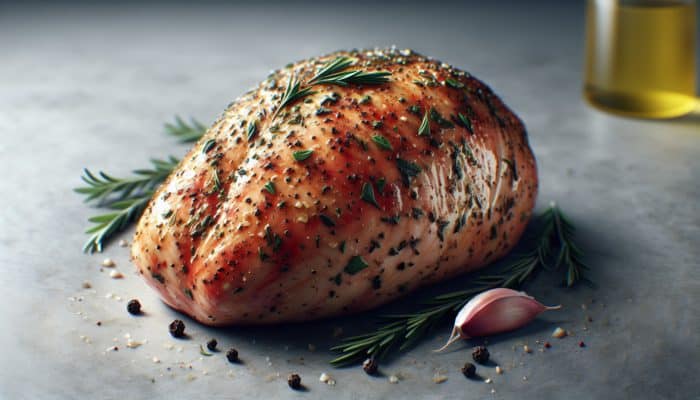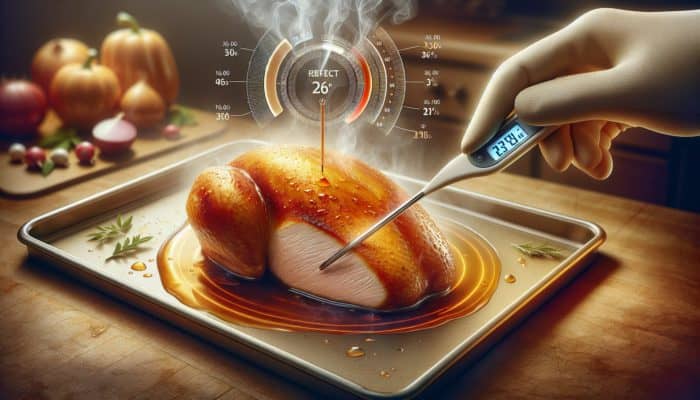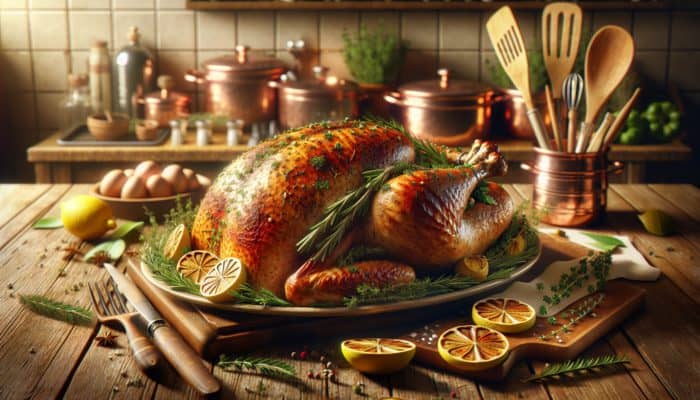Essential Steps for Preparing Your Turkey Breast
Choosing the Best Quality Turkey Breast

How to Cook a Juicy Turkey Breast: When it comes to selecting the right turkey breast, prioritising quality is paramount. Aim for a fresh, high-quality breast that exhibits sufficient marbling, as this characteristic directly impacts the flavour and tenderness of the meat. Look for breasts that display a pale pink colour, which signifies freshness, and steer clear of any that exhibit signs of frostbite or discolouration. Additionally, consider whether you want to buy a whole turkey breast or just the fillets. Whole breasts typically retain moisture better due to the skin, while fillets may be more convenient to handle and cook. If you're looking to impress at your next gathering, seek out free-range or organic options, which tend to have richer flavours stemming from their natural diet and lifestyle.
For special occasions, sourcing your turkey breast from a trusted local butcher offers the dual benefits of supporting local businesses and securing a high-quality product. Asking for recommendations or opting for heritage breeds can introduce unique flavours that significantly elevate your meal. Furthermore, consider the size of the breast in relation to your guest count; a general guideline is to plan for approximately 250-300 grams of turkey breast per person to ensure everyone enjoys a generous serving.
How Do You Safely Thaw a Frozen Turkey Breast?
Properly thawing a frozen turkey breast is crucial for achieving an even cook throughout the meat. The safest and most effective method is to utilise the refrigerator method, allowing around 24 hours for every 1.8 kilograms of turkey. This slow thawing process not only ensures safety but also preserves the meat's quality. For those who may be pressed for time, a cold water thawing method can be employed, where the turkey breast is submerged in cold water and the water is changed every 30 minutes to facilitate faster thawing.
- Always opt to thaw in the refrigerator whenever possible to maintain safety and quality.
- For quicker thawing, submerge in cold water and change the water every half hour.
- Never thaw at room temperature to prevent the risk of bacterial growth.
- Plan your cooking schedule ahead of time based on the size of the breast.
- Check the internal temperature with a thermometer to ensure proper thawing.
Following this meticulous approach to thawing not only allows for a consistent cooking process but ultimately results in a more delicious and juicy turkey breast that will delight your diners.
Can Brining Improve the Juiciness of Your Turkey Breast?
Brining is a transformative technique for enhancing the juiciness and flavour of your turkey breast. This process involves soaking the meat in a saltwater solution, enabling the turkey to absorb moisture and flavour before cooking. A straightforward brine can be created by mixing water, salt, and sugar in a large container. For optimal results, allow the turkey breast to soak in the brine for several hours or overnight, depending on the size of the breast.
To formulate a basic brine, combine 4 litres of water with 1 cup of kosher salt and 1/2 cup of sugar. You can also enhance the brine with aromatics such as herbs, spices, or citrus for additional flavour depth. It’s vital to ensure that the salt is completely dissolved before introducing the turkey. After brining, be sure to rinse the turkey breast under cold water to eliminate excess salt, then pat it dry with paper towels before seasoning. This step is essential for balancing flavours, ensuring the turkey is not overly salty while still reaping the moisture-boosting benefits of the brine.
What Are the Best Ways to Season Your Turkey Breast?

Seasoning your turkey breast is a fundamental step to amplify its natural flavour. A well-seasoned turkey breast not only enhances taste but also elevates the overall dining experience. To craft a flavourful seasoning mix, consider utilising herbs such as rosemary, thyme, garlic, and black pepper. This combination imparts a warm, aromatic quality to the dish that pairs exquisitely with the richness of turkey.
Begin by creating either a dry rub or a marinade. For a simple rub, combine 2 tablespoons of salt, 1 tablespoon of garlic powder, 1 tablespoon of black pepper, and 2 teaspoons each of dried rosemary and thyme. Generously apply this mixture over the turkey breast's surface, ensuring to work it under the skin for maximum flavour penetration. If you prefer a marinade, mix olive oil with the same herbs and spices along with a splash of lemon juice for an added zest. Marinate for several hours or overnight, allowing the flavours to meld beautifully into the turkey. This technique enhances taste while creating a delightful crust during cooking, contributing to the overall texture of the dish.
Proven Techniques for Cooking a Juicy Turkey Breast
What Cooking Techniques Ensure a Juicy Turkey Breast?
Achieving a perfectly juicy turkey breast can be accomplished through various cooking techniques, each offering unique benefits. Understanding these methods will guide you to the best choice for your occasion. Roasting, braising, and slow cooking are three popular methods that yield excellent results.
Roasting is the classic cooking technique that involves cooking the turkey breast in an oven at a suitable temperature, typically 180°C. This method caramelises the exterior, creating a beautiful golden-brown crust while locking in moisture. To enhance juiciness, regular basting with pan juices or broth can significantly improve moisture retention throughout the cooking process.
Braising, on the other hand, combines both cooking techniques. It begins with browning the turkey breast on the stovetop before transferring it to the oven or slow cooker, where it is cooked with liquid for the remainder of the cooking time. This method helps break down tougher fibres, resulting in tender, juicy meat that is incredibly satisfying.
Utilising a slow cooker allows for hands-off cooking while still achieving a moist turkey breast. By placing the turkey breast in the slow cooker with some broth or aromatic vegetables, the low-and-slow cooking process ensures that the meat becomes tender and flavorful, often falling apart at the touch.
- Roasting for a crispy exterior and moist interior.
- Braising for tenderness and depth of flavour.
- Slow cooking for hands-off convenience and juicy results.
- Grilling for a smoky flavour profile.
Each of these methods can help you achieve a juicy turkey breast, making them great options depending on your kitchen capabilities and available time.
How Can You Effectively Monitor the Cooking Process?

Monitoring the cooking process is crucial to prevent overcooked turkey breast, which can result in dry, unappetising meat. The most reliable way to ensure your turkey is cooked properly is to employ a meat thermometer. The target internal temperature for turkey breast is 74°C. Insert the thermometer into the thickest part of the breast, avoiding bones, for the most accurate reading.
Regular basting is another effective technique for maintaining moisture during the cooking process. Every 30-45 minutes, open your oven and baste the turkey with its own juices or additional broth, as needed. This not only helps keep the meat moist but also adds extra flavour as the turkey cooks.
Additionally, visual cues can guide you through the cooking process. Look for a golden-brown colour on the skin, indicating good caramelisation. If you notice the skin browning too quickly, cover the breast loosely with aluminium foil to prevent burning while the meat continues to cook. Remember to allow the turkey to rest after cooking; this enables the juices to redistribute, ensuring that each slice is as juicy as possible.
What Seasonings Are Ideal for a Turkey Breast?
To elevate the flavour of your turkey breast, consider using a blend of herbs and spices that complement its natural taste. Commonly celebrated seasonings include rosemary, thyme, garlic, and paprika. These ingredients provide a rich aroma and flavour profile that enhances the turkey without overshadowing it.
When creating your seasoning mix, a simple combination of salt and pepper can be an excellent base. Following this, incorporating dried herbs like thyme and rosemary can introduce deep, earthy flavours. For a hint of warmth, consider adding paprika or a pinch of cayenne pepper if you prefer a bit of heat.
For a more robust flavour, consider a marinade that includes a mix of olive oil, lemon juice, and crushed garlic, infused with your favourite herbs. Marinate for several hours or overnight to allow the turkey to absorb the flavour deeply. Applying a delicious rub to the surface of the meat before cooking can also enhance its overall taste and texture, providing a delectable crust as it roasts.
How Long Should You Typically Cook a Turkey Breast?
The cooking time for a turkey breast can vary based on its size and the chosen cooking method, but a general guideline is to allow 20-30 minutes per 500g at 180°C. This approximation provides a solid foundation, but the key to ensuring thorough cooking lies in monitoring the internal temperature with a meat thermometer.
For instance, if you have a 1.5 kg turkey breast, the cooking time would typically range from 60 to 90 minutes. However, using a thermometer to check for an internal temperature of 74°C is the most accurate method to ensure the turkey is fully cooked.
Resting the turkey breast after cooking is also crucial; allowing it to rest for at least 15 minutes ensures that the juices redistribute throughout the meat, resulting in a more succulent final product. This resting period is essential for achieving that perfect blend of tenderness and moisture, making each slice a delight to savour.
Different Cooking Methods for a Juicy Turkey Breast
How to Roast Your Turkey Breast to Perfection
Roasting is undoubtedly the most popular method for cooking turkey breast, renowned for its ability to produce a crispy exterior while keeping the interior juicy and tender. To begin, preheat your oven to 175°C. While the oven heats, thoroughly season the turkey breast, ensuring a generous layer of herbs and spices covers the surface.
Once seasoned, place the turkey breast in a roasting pan, skin side up. Pour a small amount of broth or water into the bottom of the pan; this creates steam during the cooking process, helping to maintain moisture. As the turkey roasts, be sure to baste it every 30-45 minutes. This step is vital for keeping the skin crispy and the meat moist, as it helps distribute the turkey's natural juices back over the surface.
Continue roasting until the internal temperature reaches 74°C. Use a meat thermometer to check the thickest part of the breast for accuracy. Once cooked, remove the turkey from the oven and allow it to rest for at least 15 minutes before carving. This resting period enables juices to redistribute, making for an exceptionally juicy turkey breast that will impress your guests.
How Long Should You Cook a Turkey Breast for Optimal Results?
The cooking time for a turkey breast can depend on several factors, including its weight and the cooking technique employed. As a general rule, you should allow 20 minutes per 450 grams at a roasting temperature of 180°C. For example, if your turkey breast weighs 1.2 kg, you should aim for a cooking time of approximately one hour and 30 minutes.
Utilising a meat thermometer is the most reliable method for ensuring proper doneness. Insert the thermometer into the thickest part of the breast, avoiding any bones, and look for a reading of 74°C. If you don’t have a thermometer, visual cues can also assist; the turkey should be golden brown on the outside, and the juices should run clear when pierced.
Regardless of the method chosen, remember to let the turkey breast rest for about 15 minutes after cooking. This crucial step allows the juices to settle within the meat, resulting in a more succulent carving experience that will delight everyone at the table.
Using a Slow Cooker for Tender and Juicy Results
Utilising a slow cooker for turkey breast can yield spectacular results, producing tender, juicy meat that practically falls apart. The beauty of this method lies in its simplicity; it requires minimal hands-on time while still delivering excellent flavour. To begin, place the turkey breast in the slow cooker and add a small amount of liquid—such as broth, wine, or even a mixture of both—to keep the meat moist during cooking.
Set the slow cooker to low and allow it to cook for 6-8 hours. This long, slow cooking process allows the connective tissues in the meat to break down, resulting in an incredibly tender turkey breast that is full of flavour. For added depth, consider incorporating chopped vegetables like onions, carrots, and celery, which can infuse the meat with a delightful taste as they cook.
When finished, check that the internal temperature of the turkey breast has reached 74°C. If you desire a crispy texture, you can transfer the cooked turkey to an oven preheated to 200°C for a quick browning, which will last about 10-15 minutes. Serve it immediately, and savour the tender, juicy results of this hands-off cooking method.
Research-Backed Insights on Cooking a Juicy Turkey Breast
What Are the Nutritional Advantages of Turkey Breast?
Turkey breast is not only a delicious protein option but also offers a wealth of nutritional benefits. As a lean source of protein, it is an excellent choice for individuals seeking to build muscle, manage their weight, or follow a healthy diet. Rich in B vitamins, particularly niacin and B6, turkey breast aids in energy metabolism and supports healthy brain function.
Additionally, turkey breast contains important minerals like selenium and zinc. Selenium plays a crucial role in antioxidant defence, helping to protect cells from damage. Zinc is essential for a healthy immune system, promoting faster healing and overall well-being. This makes turkey breast a fantastic option for those looking to boost their nutrition without excessive calories or unhealthy fats.
Moreover, turkey breast is low in saturated fat, making it a heart-healthy choice in comparison to other meats. By incorporating turkey breast into your meals, you can enjoy delicious flavours while ensuring you are providing your body with essential nutrients that support overall health.
How Does the Cooking Method Influence Nutrient Retention?
The cooking method you choose can significantly impact the nutrient content of turkey breast. Generally, roasting and slow cooking are methods that preserve more nutrients than high-heat techniques, such as frying. The gentle cooking process involved in slow cooking allows for the retention of water-soluble vitamins while also helping to maintain the meat's moisture.
When roasting, the key is to avoid excessive temperatures or prolonged cooking times that can lead to nutrient loss. Keeping the turkey breast covered during the initial stages of roasting can help retain moisture and nutrients, while regular basting ensures that the meat stays juicy.
Conversely, methods that involve high heat, like frying or grilling, can sometimes result in a reduction of certain nutrients. To optimise nutrient retention, it is best to focus on methods that involve lower temperatures and shorter cooking times, allowing the turkey breast to cook through without losing valuable nutrients.
How to Enhance Flavour Without Sacrificing Health
Enhancing the flavour of turkey breast without compromising its health benefits is entirely achievable with the right approach. Instead of relying on heavy sauces or high-fat ingredients, utilise herbs, spices, and natural marinades to infuse flavour. Fresh herbs like rosemary, thyme, and sage can add depth without contributing extra calories.
When marinating, opt for a mix of olive oil, citrus juice, and your favourite herbs. This not only boosts flavour but also provides healthy fats that can assist in nutrient absorption. For those looking to add a touch of sweetness, consider a honey or maple syrup glaze, but use it sparingly to keep the dish balanced.
Experimenting with flavour-infused broths or cooking the turkey breast with aromatic vegetables can also contribute to a rich taste profile without relying on unhealthy ingredients. This approach enables you to create a satisfying dish that aligns with health-conscious eating while ensuring the turkey breast is both delicious and nutritious.
Essential Tips for Resting and Carving Your Turkey Breast
Why Is Resting Crucial for Maintaining Juiciness?
Resting your turkey breast post-cooking is a vital step that should never be overlooked. Allowing the turkey to rest for at least 15 minutes before carving enables the juices to redistribute throughout the meat. If you skip this step, the juices will escape once you start carving, leading to dry slices that fail to showcase the breast's succulent nature.
When the turkey is cooked, the heat drives the juices towards the centre of the meat. Resting provides an opportunity for the muscle fibres to relax and absorb some of the juices back into the meat. Consequently, when you finally slice into your turkey, each piece will be packed with flavour and moisture, providing a satisfying dining experience for everyone at the table.
Additionally, resting allows the turkey to cool down slightly, making it easier to handle during carving. The exterior remains warm while the interior stabilises, ensuring that your guests are served perfectly cooked, juicy slices of turkey that are a testament to your culinary skills.
How Do You Carve a Turkey Breast Properly?
Carving a turkey breast correctly ensures that you maximise your meal and present beautifully plated slices. To start, use a sharp knife and locate the breastbone as a guide. It’s essential to carve against the grain to avoid chewy pieces of meat and create tender slices. Begin by making a few incisions along the side of the breastbone, cutting through until you reach the rib cage.
Once you've made the initial cuts, gently pull the breast away from the bone, severing any connective tissue. Continue slicing the turkey breast into even, thin pieces, approximately 1-2 cm thick. If you prefer, you can remove the breast entirely from the bone before slicing for easier serving.
Remember to collect any juices that run off while carving; they can be drizzled over the sliced turkey for added moisture and flavour. By following these techniques, you can ensure that each slice reflects the effort you put into preparing a juicy, delicious turkey breast that will impress your guests.
What Is the Best Way to Store Leftover Turkey Breast?
Proper storage of leftover turkey breast is crucial to maintain its safety and quality. After serving, ensure that any leftover turkey is refrigerated within two hours of cooking to prevent bacterial growth. Place the turkey breast in an airtight container or tightly wrap it in aluminium foil to keep it fresh and delicious.
Once stored, aim to consume the leftover turkey within 3-4 days for optimal quality. If you find yourself with an abundance of leftovers, consider freezing portions in airtight containers or freezer bags. This allows you to enjoy the delicious flavours of turkey breast long after the initial meal has concluded.
For optimal quality when reheating, thaw frozen turkey in the refrigerator before warming. Reheat in the oven or microwave until it reaches an internal temperature of 74°C. Always add a splash of broth or water when reheating to prevent the food from becoming dry. By following these storage methods, you can continue to savour your turkey breast while ensuring it remains safe and delectable for future meals.
Delicious Serving and Pairing Ideas for Your Turkey Breast
What Are the Most Complementary Side Dishes for Turkey Breast?
Turkey breast pairs beautifully with a variety of side dishes that complement its flavour and texture. Timeless classics such as mashed potatoes, green beans, and stuffing are always crowd-pleasers. The creamy texture of mashed potatoes provides a rich contrast to the lean turkey, while green beans add a fresh crunch that balances the dish perfectly.
For those looking to lighten the meal, consider serving turkey breast alongside a refreshing salad or roasted vegetables. A simple mixed greens salad with a tangy vinaigrette can cut through the richness of the turkey, making for a delightful pairing. Roasted root vegetables, such as carrots, parsnips, and Brussels sprouts, not only add vibrant colour to the plate but also offer a sweet, caramelised flavour that complements the savoury notes of the turkey.
For a unique twist, consider wild rice or quinoa pilaf as a side dish, which provides additional texture and nutrition. Incorporating fruits, such as cranberries or apples, into your side dishes can also enhance the overall dining experience, allowing you to highlight the flavours of the turkey breast beautifully.
How Can You Elevate Your Turkey Breast Dish to Impress Guests?
Elevating your turkey breast dish can be achieved through various techniques that introduce gourmet elements without excessive effort. One effective method is to create a gourmet sauce that enhances the natural flavours of the turkey. Consider making a cranberry glaze or a herb-infused butter that can be drizzled over the slices just before serving. These additions bring a burst of flavour that elevates the entire dish while remaining aligned with classic turkey pairings.
Another way to elevate your turkey breast is by experimenting with unique seasonings and flavour profiles. Consider introducing Asian-inspired marinades or spices, such as five-spice powder or ginger, to create a completely different taste experience. For a Mediterranean flair, a mix of olive oil, lemon, and fresh herbs can bring brightness and vibrancy to the dish.
Presentation also plays a vital role in elevating your meal. Use a large wooden board or platter to artfully arrange the carved turkey breast, garnished with fresh herbs or slices of citrus fruit. This not only makes for an appealing sight but also enhances the dining experience, turning your turkey breast into a celebratory dish that your guests will remember.
What Are the Best Wine and Beverage Pairings for Turkey Breast?
Pairing the right beverage with your turkey breast can greatly enhance the overall dining experience. For a classic pairing, consider opting for white wines such as Chardonnay or Sauvignon Blanc, both of which complement the meat's flavours beautifully. A lightly oaked Chardonnay can enhance the creamy textures often present in turkey dishes, while Sauvignon Blanc's acidity cuts through richness, making each bite more enjoyable.
If you prefer red wines, a light-bodied Pinot Noir can work wonders, offering vibrant fruit notes that balance well with turkey's savouriness. The subtlety of a Pinot Noir ensures that it doesn't overpower the flavours, instead complementing them gracefully.
For non-alcoholic options, consider pairing your turkey breast with a refreshing sparkling cider or a herbal tea. Sparkling cider adds a touch of sweetness and effervescence, enhancing the meal's overall feel, while herbal teas can provide relaxation and balance, perfect for a leisurely dining experience.
Frequently Asked Questions About Cooking Turkey Breast
How can I ensure my turkey breast stays juicy while cooking?
To keep your turkey breast juicy, consider brining it before cooking, using a meat thermometer to avoid overcooking, and regularly basting it during the cooking process for added moisture and flavour.
What should I do if my turkey breast is still frozen?
If your turkey breast is frozen, the safest method to thaw it is in the refrigerator, allowing 24 hours for every 1.8 kilograms. Alternatively, submerge it in cold water, changing the water every 30 minutes to expedite the thawing process.
Can I cook a turkey breast without skin?
Yes, you can cook a turkey breast without skin, but it may be less juicy. Brining or using a marinade can help enhance moisture and flavour in skinless breasts, ensuring a satisfying result.
How do I know when my turkey breast is fully cooked?
The best way to ensure your turkey breast is cooked is to use a meat thermometer. Insert it into the thickest part, and it should read 74°C to confirm doneness and safety.
What are some creative ways to use leftover turkey breast?
Leftover turkey breast can be used in a variety of dishes, including soups, sandwiches, or salads. It can also be shredded for tacos or mixed into a pasta dish for added protein and flavour.
Is it necessary to baste the turkey breast while cooking?
Basting helps keep the turkey breast moist and adds flavour, but it is not strictly necessary. If using a cooking method that retains moisture, such as slow cooking, basting may not be required for optimal results.
What are the benefits of using a slow cooker for turkey breast?
Using a slow cooker for turkey breast allows for hands-off cooking, resulting in incredibly tender and juicy meat. The low, slow heat effectively breaks down connective tissues for optimal texture and flavour.
Can turkey breast be cooked from frozen?
While it is best to thaw turkey breast before cooking for even results, you can cook it from frozen. However, cooking time will be significantly longer, and it's essential to ensure it reaches an internal temperature of 74°C for safety.
What are the best sides to serve with turkey breast?
Classic sides that pair well with turkey breast include mashed potatoes, green beans, stuffing, and cranberry sauce. For lighter options, consider a salad or roasted vegetables for a refreshing balance.
Can I use dried herbs instead of fresh for seasoning turkey?
Yes, dried herbs can be used as a substitute for fresh herbs when seasoning turkey. Generally, use one-third the amount of dried herbs compared to fresh to achieve optimal flavour without overwhelming the dish.


